| Srl | Item |
| 1 |
ID:
179027
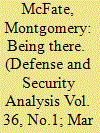

|
|
|
|
|
| Summary/Abstract |
This article argues that the US Navy’s roles (which have historically been bifurcated between warfighting and political use of force) manifest in its organisational culture as two different concepts of war: the US Navy as diplomatic actor and the US Navy as warfighting force. The conflict between these different concepts of war can be seen in the current debate about the definition and function of presence. The debate about presence is not just theoretical, but represents a deep and enduring conflict within the Navy as an organisation about its concept of war. Since the end of WWII, the Navy has been designing its fleet architecture according to a Mahanian concept of war, despite the preponderance of non-lethal missions and activities. The result is a mismatch between platforms and tasks.
|
|
|
|
|
|
|
|
|
|
|
|
|
|
|
|
| 2 |
ID:
179029
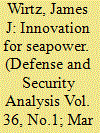

|
|
|
|
|
| Summary/Abstract |
A call for innovation as a means to outpace the acceleration of technological change and to bolster capabilities quickly is a central theme of contemporary U.S. Naval Strategy. The need for innovation is accepted, but the integration of readily available technologies into the Fleet is slow. Innovation unfolds according to “Navy-Time,” a cycle lasting between a long-decade and thirty-years. To accelerate the innovation process in the U.S. Navy, the article offers a Concept of Operations for Innovation that outlines how a deliberate process of analysis, weaponisation and integration can move new ideas and weapons into the Fleet in a strategically relevant time-frame.
|
|
|
|
|
|
|
|
|
|
|
|
|
|
|
|
| 3 |
ID:
179028
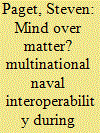

|
|
|
|
|
| Summary/Abstract |
The increasing frequency of multinational operations has heightened the importance of interoperability. While human and cultural factors are only two pieces of the interoperability jigsaw they are of enduring significance. The cohesiveness of the relationship amongst the Royal Australian Navy, the Royal Navy and the United States Navy during the 2003 Iraq War was underpinned by high levels of perceptive interoperability, which manifested itself in effective working relationships. That conflict demonstrated that while historical ties provided a foundation for cooperation, a number of multinational initiatives were undertaken to further enhance interoperability. This article addresses how such a high level of perceptive interoperability was achieved by examining the conduct of multinational exercises, the importance of personnel exchanges and the role of liaison officers, before considering the effect it had on the conduct of operations. The Iraq War demonstrated that cultural factors are at least as important as other facets of interoperability.
|
|
|
|
|
|
|
|
|
|
|
|
|
|
|
|
| 4 |
ID:
179025
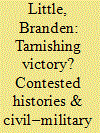

|
|
|
|
|
| Summary/Abstract |
As the First World War came to an end, the U.S. Navy's leadership engaged in a bitter fight over the “lessons” of the war. Admiral William S. Sims and Secretary of the Navy Josephus Daniels fought against each other's irreconcilable positions. Sims argued that the Navy Department's inexpert civilian secretary had hamstrung mobilisation, impeded the anti-submarine campaign, and ostracised capable officers in favour of friends upon whom he bestowed medals. Daniels countered that his administration had masterfully responded to the crisis of war. The Navy's record, Daniels insisted, could best be summarised as “a great job greatly done.” Only disloyal nit-pickers could find fault in its accomplishments. The Sims-Daniels controversy raged in congressional hearings, the press, and in partisan histories written by the protagonists. The heart of the dispute and its uncertain resolution rested in radically different understandings of American civil–military relations, naval heroism, and the determinants of victory.
|
|
|
|
|
|
|
|
|
|
|
|
|
|
|
|
| 5 |
ID:
179026


|
|
|
|
|
| Summary/Abstract |
Discussion surrounding the announcement of a new NATO Maritime Command for the North Atlantic seems to have settled on the assumption that there is again a vital “sea-line of communication” (SLOC) between North America and Europe as there was supposed to be during the Cold War. The Soviet Union had a large fleet of nuclear and conventional submarines and it seemed very clear that Soviet admirals intended to fight a third “Battle of the Atlantic” in the event of war to prevent Western resupply of NATO. However, this scenario bore no resemblance to what the Soviet Navy actually intended to do in case of war. Changes in technology, notably in submarine propulsion, antisubmarine warfare (ASW), and ballistic missile range and accuracy were the real drivers of the Cold War in the Atlantic. Cruise missile-armed submarines that can attack shore-based economic infrastructure are the real threat from the Russian submarine force.
|
|
|
|
|
|
|
|
|
|
|
|
|
|
|
|
| 6 |
ID:
179031
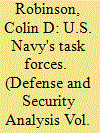

|
|
|
|
|
| Summary/Abstract |
Grouping warships for combat has evolved greatly over the centuries. In the early 1940s, the United States Navy began to group its warships for combat in much more flexible task forces than the previous single-type-of-warship formations. This system has evolved and spread to naval forces ashore but remains fundamentally unchanged. It now covers numbers between 1 to over 1000, of which the most prominent is the first 100 or so which U.S. Navy combat forces use. The numbered fleets worldwide utilize the series covering 20-79; 1-19 and 90-99 appear to be reserved for special allocations and Commander, Pacific Fleet; numbers over 80 to the Atlantic; 100-119 for Northern Europe and briefly Tenth Fleet; the 120 series for Second Fleet as a Joint Task Force leader; the 150 series for Naval Forces Central Command; and the 180 series for Atlantic Fleet and now-Fleet Forces Command.
|
|
|
|
|
|
|
|
|
|
|
|
|
|
|
|
| 7 |
ID:
179030


|
|
|
|
|
| Summary/Abstract |
For the first time in a generation, the US Navy finds itself in an era of great power competition. As US naval strategists and defense planners begin to organise materially and conceptually to confront the strategic and operational-level challenges posed by China and Russia, what should they keep in mind? What should frame their thinking? Absorbed with the day-to-day tasks associated with managing how the fleet is being built, operated, and rationalised, these busy officers and civilians seldom can step back and gain some perspective on fundamental aspects of the security environment and relate those to naval purpose. To that end, this article provides a primer on what to keep in mind and how to think in an era of maritime great power competition.
|
|
|
|
|
|
|
|
|
|
|
|
|
|
|
|